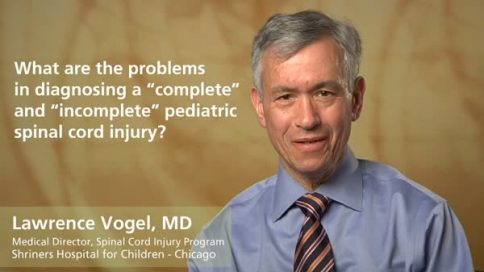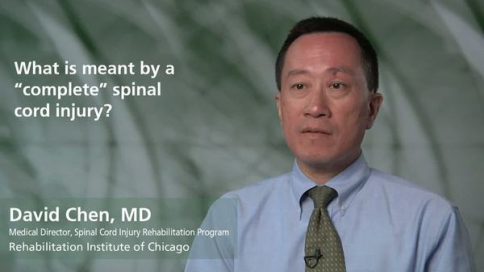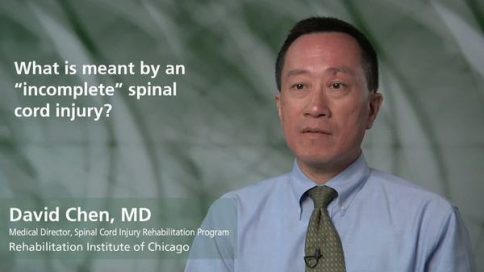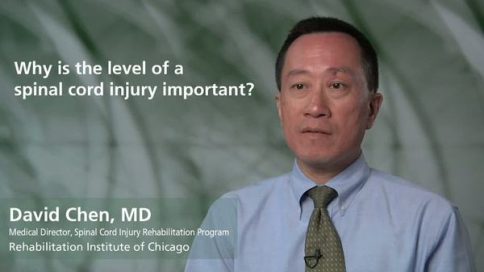What do the terms “complete” and “incomplete” spinal cord injury mean? - Lawrence Vogel, MD
|
|
What do the terms “complete” and “incomplete” spinal cord injury mean? |
|
Lawrence Vogel, MDMedical Director, Spinal Cord Injury Program, Shriners Hospital for Children, Chicago |
||
| Read Bio | More Videos by Lawrence Vogel | |
|
Share |
||
Transcript
It’s a common misconception that people have that if you have a complete spinal cord injury, it means that the spinal cord is been completely severed, like as though they took a knife and cut it. But the vast majority of spinal cord injuries, even complete, the spinal cord, if you look at it with the naked eye, would look pretty normal to us. The damage to spinal cords, whether or not it’s complete or incomplete, it’s really primarily at a microscopic level. So, one has initially an inflammatory response, with edema or swelling of that area of the spinal cord, and as a result of that inflammation and swelling, one can then have cell death and hemorrhage. Just like you have a bruise on your arm, you’d have a bruise on the spinal cord. And that’s what kills the cells, and causes the spinal cord damage. If we could look inside the spinal cord, and see the tracks that go up and down, that basically connect our brain to our feet. So if we say, “I want to move my foot,” the message starts in my brain, sends the message down the spinal cord, then to a nerve, and then to my leg muscle to move. That’s how we usually would move something. Opposite is by feeling, we would stimulate a nerve fiber in our foot for instance, sends a message up our, via nerve to our spinal cord, up to our brain. But with a spinal cord injury, those transmissions are either completely stopped, or partially stopped. And so, if you have a complete lesion theoretically, the vast majority, if not all of those tracks that are going up and down, have been damaged one way or another. The truth is that probably even in complete lesions, there may be a few fibers that are still running up and down, but they’re not enough for you to be able to voluntarily move your leg, or to have sensation. The other thing that happens, in addition to loss of fibers, is we lose something called myelin. And myelin is an insulation that our nerve fibers have; it’s kind of like electric any kind of electric cord. The way electricity flows is you have to have an insulation, so the electricity goes in one direction, doesn’t kind of dissipate all over the place. So we have this, something called myelin around our nerve fibers, or axons, that help transmit our messages from one place to another. So after a spinal cord injury, for many reasons, our, these axons lose their myelin, or their insulation, and even if there exists, transmission is slower or very poor. Clearly spinal cord injuries, if they’re complete, have major impact on one’s gross motor function. On the other hand, there’s all different extremes of incomplete spinal cord injuries, to having sensory preservation, to those who have some motor abilities, to almost to normal.
Show Less|
|
||
add
What do the terms “complete” and “incomplete” spinal cord injury mean? |
||
Lawrence Vogel, MDMedical Director, Spinal Cord Injury Program, Shriners Hospital for Children, Chicago |
More Videos by Lawrence Vogel | |
| Transcriptadd | share | |
It’s a common misconception that people have that if you have a complete spinal cord injury, it means that the spinal cord is been completely severed, like as though they took a knife and cut it. But the vast majority of spinal cord injuries, even complete, the spinal cord, if you look at it with the naked eye, would look pretty normal to us. The damage to spinal cords, whether or not it’s complete or incomplete, it’s really primarily at a microscopic level. So, one has initially an inflammatory response, with edema or swelling of that area of the spinal cord, and as a result of that inflammation and swelling, one can then have cell death and hemorrhage. Just like you have a bruise on your arm, you’d have a bruise on the spinal cord. And that’s what kills the cells, and causes the spinal cord damage. If we could look inside the spinal cord, and see the tracks that go up and down, that basically connect our brain to our feet. So if we say, “I want to move my foot,” the message starts in my brain, sends the message down the spinal cord, then to a nerve, and then to my leg muscle to move. That’s how we usually would move something. Opposite is by feeling, we would stimulate a nerve fiber in our foot for instance, sends a message up our, via nerve to our spinal cord, up to our brain. But with a spinal cord injury, those transmissions are either completely stopped, or partially stopped. And so, if you have a complete lesion theoretically, the vast majority, if not all of those tracks that are going up and down, have been damaged one way or another. The truth is that probably even in complete lesions, there may be a few fibers that are still running up and down, but they’re not enough for you to be able to voluntarily move your leg, or to have sensation. The other thing that happens, in addition to loss of fibers, is we lose something called myelin. And myelin is an insulation that our nerve fibers have; it’s kind of like electric any kind of electric cord. The way electricity flows is you have to have an insulation, so the electricity goes in one direction, doesn’t kind of dissipate all over the place. So we have this, something called myelin around our nerve fibers, or axons, that help transmit our messages from one place to another. So after a spinal cord injury, for many reasons, our, these axons lose their myelin, or their insulation, and even if there exists, transmission is slower or very poor. Clearly spinal cord injuries, if they’re complete, have major impact on one’s gross motor function. On the other hand, there’s all different extremes of incomplete spinal cord injuries, to having sensory preservation, to those who have some motor abilities, to almost to normal.





